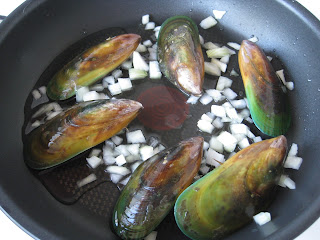 We were discussing our gardens at work the other day, when Renai mentioned she had a whole heap of beetroot growing, and no idea what to do with it. On hearing that I still had to make beetroot salad (p175) she offered me some, which I accepted very readily.
We were discussing our gardens at work the other day, when Renai mentioned she had a whole heap of beetroot growing, and no idea what to do with it. On hearing that I still had to make beetroot salad (p175) she offered me some, which I accepted very readily.I came home today with a bag of Renai's lovely fresh beetroot, gave them a quick scrub before putting them on to boil - roots and base of stalks attached. These were going to take a while to cook, which fit in quite nicely with cooking the soused fish (p118) I intended to serve with it.
 If I were following the soused fish recipe correctly, I should have got a whole fish and cut it into steaks. I didn't see the point in that (how long would it take me to eat that many fish steaks?) so I figured I'd just buy a single fish steak and cook it in the same way. Salmon was one of the suggested fish, and salmon steaks aren't hard to come by, are they?
If I were following the soused fish recipe correctly, I should have got a whole fish and cut it into steaks. I didn't see the point in that (how long would it take me to eat that many fish steaks?) so I figured I'd just buy a single fish steak and cook it in the same way. Salmon was one of the suggested fish, and salmon steaks aren't hard to come by, are they?Well, I couldn't find any at the local supermarkets. Not this week, anyway. I wasn't in the mood to go traipsing all over town for a particular ingredient, so I just got a salmon fillet instead.
A quick Google search has given me a rough definition of 'sousing': it means 'to pickle or drench in liquid'. That's pretty much what I did here - placing the fish in a casserole dish, then covering with water and adding vinegar, herbs, salt and peppercorns, before putting it in a low oven for an hour or so (the recipe is for 1 1/2 hours, but it's also for a whole fish worth of steaks. I figured one hour would be plenty for a single fillet).

Oops: I just noticed that the fish was supposed to be covered while cooking. Oh well, too late now.
When the fish came out of the oven, I let it cool a little, the removed it from the cooking liquid (it doesn't say whether to do this or not; I just figured it would chill quicker) and placed it in the fridge. That's right: this fish is to be served cold.
Around the same time as I took out my fish, I took the beetroot off the heat. They looked like they were cooked - the skins seemed loose and wrinkly, which was a good sign.
 I drained the beetroot, and as soon as they were cool enough, I began to slip off the skins. They came off without difficulty - a definite improvement on previous attempts. When the skins, roots and stalks were removed, I had a bowl of tidy-looking little bits of beetroot - and hardly any purple splatters around my kitchen!
I drained the beetroot, and as soon as they were cool enough, I began to slip off the skins. They came off without difficulty - a definite improvement on previous attempts. When the skins, roots and stalks were removed, I had a bowl of tidy-looking little bits of beetroot - and hardly any purple splatters around my kitchen!I cut the beetroot into wedges, then added the other ingredients: chopped spring onion, parsley, sugar dissolved in boiling water, salt and pepper, and a generous slosh of malt vinegar. I quickly tossed these together, and put the salad in the fridge to cool.
A little while later, I served myself up some of the salad, and about half of the salmon fillet, adhering strictly to the recipe with a garnish of lemon and parsley.
 The salad didn't look quite as colourful, now that the beetroot had bled a reddish tinge into the spring onion, but that didn't matter: it was really pleasant to eat. The The beetroot was soft and tender, and the dressing was tangy, but not overpowering. Come to think of it, I might put some beetroot in my garden next year!
The salad didn't look quite as colourful, now that the beetroot had bled a reddish tinge into the spring onion, but that didn't matter: it was really pleasant to eat. The The beetroot was soft and tender, and the dressing was tangy, but not overpowering. Come to think of it, I might put some beetroot in my garden next year!And the salmon? You'd think it would be weird, eating cold fish, but it's not. It's actually quite tasty - moist and juicy with a slight hint of vinegar. One part of my fish was slightly dry; this was the thickest part from the centre that wasn't quite covered with water during the cooking. Next time (yes, I might make this again) I'll make sure all the fish is totally immersed - and let's not forget the casserole dish is supposed to be covered durng the cooking, too! I also think it'd be better to chill the fish in the cooking liquid, instead of taking it out.
On the whole, I was pretty pleased with my chilled plateful. An ideal summer meal, really. On the face of it, it looks like both the beetroot and the soused fish take a long time to cook, but that doesn't mean there's really much effort involved. Both of these are definitely worth trying.
























































